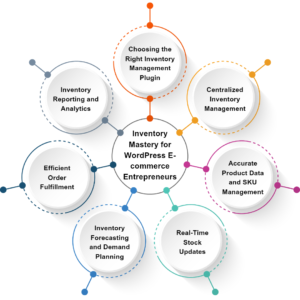WordPress has emerged as a popular platform for entrepreneurs looking to start their own e-commerce businesses. With its user-friendly interface and extensive plugin ecosystem, WordPress provides a solid foundation for online stores. However, one crucial aspect that every WordPress e-commerce entrepreneur must master is inventory management. In this blog post, we will explore the key strategies and best practices for effectively managing inventory on WordPress, ensuring smooth operations and maximizing profitability.

Choosing the Right Inventory Management Plugin:
WordPress offers a range of inventory management plugins tailored specifically for e-commerce businesses. Look for plugins that integrate seamlessly with your chosen e-commerce plugin (such as WooCommerce) and provide features like real-time inventory tracking, low-stock notifications, and easy product categorization.
Centralized Inventory Management:
As your e-commerce business grows, managing inventory across multiple channels can become complex. Centralized inventory management solutions help you streamline operations by syncing inventory levels across your WordPress store and other platforms like marketplaces and social media shops. This ensures accurate stock visibility and prevents overselling or stockouts.
Accurate Product Data and SKU Management:
Maintaining accurate product information is essential for effective inventory management. Ensure each product has a unique SKU (Stock Keeping Unit) to track it individually. Properly categorize and tag products, and regularly update attributes like dimensions, weight, and variants. This ensures accurate stock calculations, better order fulfillment, and improved customer satisfaction.
Real-Time Stock Updates:
An essential aspect of inventory management is keeping track of stock levels in real-time. Leverage plugins that provide automatic stock updates, so customers are aware of product availability at all times. Real-time stock updates also help you identify fast-selling products, slow-moving items, and seasonal trends, enabling you to optimize your inventory and marketing strategies.
Inventory Forecasting and Demand Planning:
To avoid overstocking or stockouts, effective inventory management requires forecasting and demand planning. Analyze historical sales data and use tools to predict future demand. This enables you to optimize inventory levels, plan for promotions or seasonal fluctuations, and make informed purchasing decisions.
Efficient Order Fulfillment:
Smooth order fulfillment is crucial for customer satisfaction. Automate order processing as much as possible by integrating your WordPress store with fulfillment services or shipping carriers. Ensure that your inventory management plugin updates stock levels in real-time as orders are processed, reducing the risk of overselling.
Inventory Reporting and Analytics:
Regularly review inventory reports and analytics to gain insights into your business’s performance. Track key metrics such as inventory turnover rate, stock value, and profitability by product category. Identify slow-moving or obsolete inventory to make informed decisions on markdowns, promotions, or discontinuation.
In Short, Mastering inventory management is vital for WordPress e-commerce entrepreneurs to maintain efficient operations and maximize profitability. By choosing the right inventory management plugin, centralizing inventory management, maintaining accurate product data, and utilizing real-time stock updates, entrepreneurs can ensure smooth order fulfillment and optimal inventory levels. Additionally, leveraging inventory forecasting, efficient order fulfillment, and monitoring inventory reports and analytics will help drive informed decision-making for long-term success. With these strategies in place, WordPress e-commerce entrepreneurs can navigate the challenges of inventory management and set their businesses up for growth and profitability.
Check out our Previous Blogs- Keep Up With All The Latest In The Digital World







